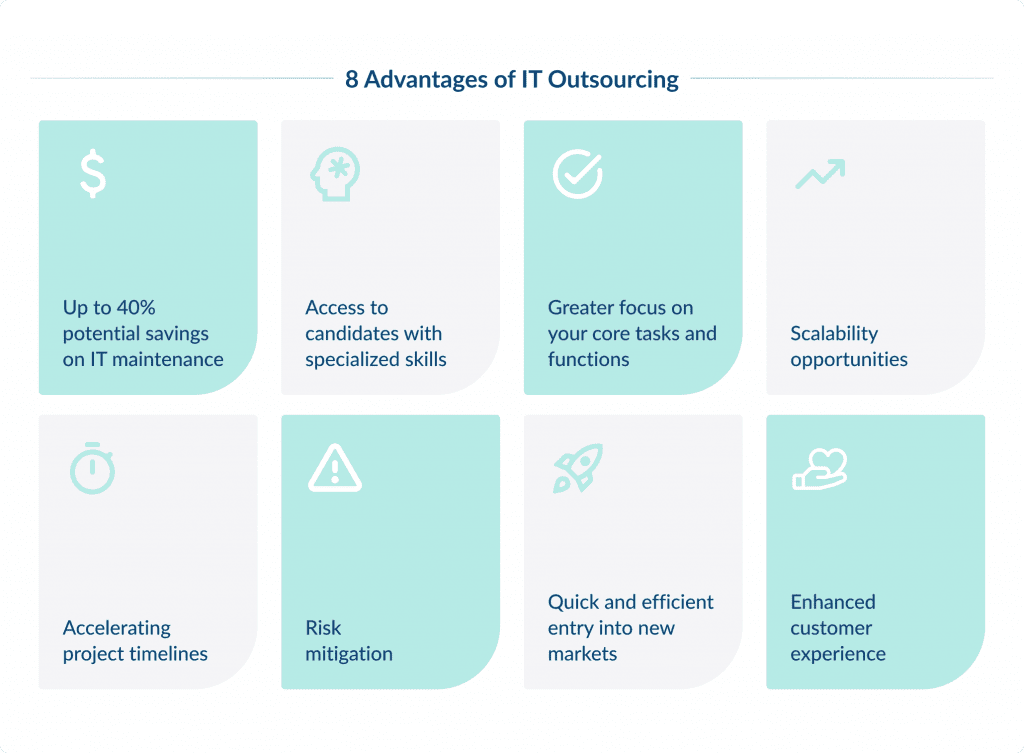IT Outsourcing: What is it, Types, and Best Practices for 2025
- Created: Mar 15, 2024
- 9 min
Cost-saving, pain-solving, and more relevant than ever, outsourcing has become a proven lifesaver for businesses struggling with budget, staff, or expertise. With about 300,000 jobs outsourced yearly in the US alone, outsourcing is here to stay.
It’s only a matter of time before your startup, project, or brand needs to hire external help or delegate a chunk of workflow.
What does it mean to outsource a project, task, or responsibility? Let’s dig in and find out.
Transform your ideas into reality with top-tier software developers — contact us to get started!
What is IT Outsourcing?
The global expansion of the IT sector, with its technological adoption and integration with daily life, has formed the biggest market of services and products outside of traditional (non-digital) industries.
The rise of advanced tech we’ve witnessed over the years drives a huge demand for tech specialists — administrators and project managers, designers and developers, testers and analysts. You name it.
So much so that the IT market’s players (agencies, e-stores, corporations, etc.) often struggle to recruit exactly the talent they need. The biggest common issue for any company with an IT department, project, or startup is gathering a multi-purpose staff that would cover most workflow aspects (if not all).
And still, various performance and productivity gaps can emerge most unexpectedly. This is where outsourcing helps a ton.
Top reasons for a company to outsource
In a nutshell, outsourcing is a perfect helping hand for an IT company or project that has:
- No specialist to handle a workflow aspect, use advanced technology, or offer new solutions to old issues
- Not enough essential specialists on the team in general (e.g., no PM or tech lead)
- No time to fit a set deadline with existing resources
- Not enough budget to finance recruitment and management of a hired dedicated development team
Another question is, what to outsource in IT? Let’s see.
A company with no worker shortage may lack specialists with the skills to organize and coordinate daily work. For instance, in the early days of emerging DevOps techniques, universally skilled specialists who could combine development and management responsibilities were so scarce you could ONLY outsource them.
As another example, realizing the importance of data and gaining new methods to analyze it, companies would also hire outsourced BA analysts and data encryption specialists. Simply because not all IT projects by far bothered employing such professionals from the start.
3 Types of Outsourcing
There are more use cases and benefits of IT outsourcing, but let’s first define the basic outsourcing types and models you can choose to employ today.
Onshore outsourcing
The default, fastest, yet not the most cost-efficient option. Onshore outsourcing is when you turn to providers that are based in the same country as you are. It’s easier to connect with the providers working in the same time zone, under the same legislation, and sharing the same culture.
This must be why so many American companies readily turn to outsourcing. However, the high cost of local IT outsourcers is often the main reason why business owners and startuppers turn to outsourcing in the first place. So, this method only fits capable companies and projects.
Who uses it: Small to medium-sized businesses (SMBs) or enterprises seeking local expertise and compliance with domestic regulations.
Key takeaways:
- Closer proximity for hassle-free collaboration.
- Fewer difficulties complying with local industry regulations.
- Generally higher costs compared to dedicated offshore development alternatives.
Nearshore outsourcing
Nearshore outsourcing gives access to service providers from neighboring countries or regions. This approach combines the benefit of proximity with potential cost savings. Are local IT service prices overly expensive?
You may find a much better-priced option delivered at the same level of quality in a country that isn’t too distant and culturally different. That is, if you do have such a neighbor, and they have a well-developed IT market.
Who uses it: Companies located in regions with limited local resources or seeking cost-effective solutions without compromising proximity.
Key takeaways:
- Focus on the balance between cost-savings and proximity.
- Easier to travel for meetings and collaboration.
- Talent pools with similar cultural backgrounds.
Offshore outsourcing
A country may have an overall lower cost of living than that where you’re based. But that doesn’t always mean its specialists are poorly educated or in any way inferior to your locals. Offshore outsourcing turns this into a business advantage.
You can delegate work to specialists in distant regions, tapping into wider talent pools at lower labor costs. Yes, it may come with its own challenges (language, time zone, etc.). But an offshore approach pays off tenfold if you know where to look, prepare, and partner up with a reliable provider.
Successful apps are often the result of strong partnerships. Learn how to build one in our article on app development partnerships.
Who uses it: Large enterprises and global corporations seeking to leverage cost advantages and access specialized skills unavailable locally.
Key takeaways:
- Felt cost savings due to the global difference in rates.
- A talent pool of some of the brightest minds with specialized skills.
- May involve challenges related to communication and cultural differences.
3 Models of Outsourcing
No matter how far your outsourced workforce is located, they are usually ready to collaborate based on one of the following models.

Project-based outsourcing
In the project-based outsourcing model, companies/projects turn to external service providers to complete specific projects or tasks within a defined scope and timeframe.
This model is perfect when you are looking for some short-term initiatives to quickly fix some gaps in a well-planned project. Like when you have a running workflow yet struggle with a certain metric that requires some narrowed-down expertise (e.g., BI analytics).
Who uses it: Businesses with one-time or short-term projects requiring specialized expertise not available in-house.
Specifics:
- Flexibility for short-term projects with specific objectives.
- You get to leverage specialized skills on demand.
- Requires clear project scope, timelines, and deliverables for successful execution.
Dedicated team model
With the dedicated model, you can hire a full-stack or custom team of professionals to work exclusively for your needs.
Naturally, this gives more control over workflow management and resource allocation. Outsourcing providers usually offer team leads and project managers from their talent pool, with the option of retaining your own PM if you already have one.
Who uses it: Companies with ongoing or long-term projects need dedicated resources and continuous collaboration.
Specifics:
- You decide how to manage resources and workflows.
- Allows for long-term collaboration and experience sharing.
Outstaffing model
Outstaffing allows you to introduce outsourced specialists to your existing team as full-on members.
But only for now – you basically “rent” the workforce, saving tons on recruitment and employment. Even better, you can let go of outstaffed workers whenever needed without firing anyone. This is an excellent option for small businesses looking to scale and complete industry-specific tasks without hiring expensive professionals full-time.
Who uses it: Businesses experiencing fluctuations in project workload or requiring additional resources for specific tasks.
Use cases:
- There’s a need to scale project resources up/down, cut or add things on demand.
- You can’t afford to hire full-time staff but still need specialized skills.
- The top priority is the smooth integration of in-house and outsourced teams (explore the difference between in-house development vs outsourcing).
Unlock the power of WordPress with our experts.
8 Advantages of IT Outsourcing
Now, let’s see some reasons to go for outsourcing in the first place.
Saving costs
IBM was able to cut $2 billion(!) of unnecessary and hidden budget expenses through outsourcing. That says enough, eh? If you take the same route, you can expect to save up to 40% of your normal IT maintenance budget.
Handpicking talent
Outsourcers give you well-tried, carefully pre-screened job candidates with a skill set that matches your requirements. This can be particularly valuable for projects requiring niche or advanced technical knowledge.
Focusing on core IT
A small business can offload routine tasks in favor of focused performance. Data entry, maintenance, and other manual tasks can all be outsourced while your team handles the project’s or company’s core. Learn more about IT outsourcing for small business.
Seeking scalability
Getting freedom of scaling is a huge business advantage. It can be especially beneficial for tackling dynamic, unpredictable demand and handling short-term goals through fast hiring or out-staffing.
Speeding up time to market
Outsourcing is a real remedy for projects running on a tight schedule. IT is an arena of rapid technological evolution and ever-shifting demands, and missed deadlines can cost too much.
Tackling risks
Project delays, hidden costs, security breaches, and failed RoI are common risks to tackle via outsourcing. You may also need blockchain or other complex tech in a project and not have your own specialist.
Expanding presence
A company gets to reach new markets without expanding physical infrastructure or international expansion. This is particularly advantageous when looking to enter new geographic regions.
Doubling down on customer experience
Freed-up internal resources can be invested in customer experience, satisfaction, and loyalty. For instance, an e-commerce company can adopt a customer-centric approach to retain customers and grow revenue.
To better understand your business’s financial health, our ARR calculator is a valuable tool.

IT Outsourcing Risks and Pro Tips
While IT outsourcing offers numerous benefits, be prepared for the following challenges.
Finding a reliable partner
To avoid unreliable or inexperienced providers, thoroughly research potential outsourcing partners, checking references, portfolios, and customer reviews. Look beyond the surface, paying special attention to certificates and Cluth/GitHub reviews.
Addressing security
Intellectual Property is considered one of a company’s most prized possessions. Pick a provider that is extra diligent about following regulations like ISO/IEC 27001 (an international information security requirements standard) and GDPR (when you tap into European outsourcing markets).
Learn about the most impactful cybersecurity trends to safeguard sensitive data and prevent breaches.
Anticipating quality
It’s difficult to be completely confident in the quality of work your newly hired external service provider delivers. Reputable outsourcers usually have Clutch reviews and ratings, offer contract-based partnerships, and consult with you throughout the process.
3 Best Countries to Outsource Your IT Department
Based on stats, market research, and experience over the years, we can identify these top outsourcing destinations for 2025.
Ukraine – Leading IT Outsourcing Country
Ukraine remains a top destination for IT outsourcing, offering high-quality work at competitive rates. It has a billion-worth IT outsourcing market that’s projected to hit over two billion by 2028. There’s a huge pool of professionals, a favorable business environment, and a strong educational system.

Ukrainian software developers create unique projects like Grammarly and People.ai, not to mention all the Facebook and Google employees hailing from the country. There are plenty of highly educated, skilled specialists, so the competition is always on, which means their rates remain reasonable.
The IT industry pool counts up to 170,000 specialists available for hire. Most speak English fluently, and 50% of specialists possess a STEM education degree. This is the highest level of proficiency in the region. And you can buy it for about $25-50 per hour.
Poland – Good Services at High Prices
A Central European outsourcing leader. The only downside is that the cost of a Polish IT specialist’s hours is one of the highest in the region, reaching $99 per hour. The local outsourcing industry employs 250,000 professionals.
With a high level of English and proximity to Western Europe, Poland offers a proven and stable outsourcing option. There are around 500,000 IT specialists in the country in all, making up a formidable IT services segment.
The Philippines – Emerging IT Outsourcing Provider
The Philippines is an emerging outsourcing destination where the market is yet to ripen, but you can easily acquire handpicked talent at more than competitive rates. Opting for a growing market can be a surprisingly efficient choice. There is a 0.79-billion-rich IT segment with steady growth. And while the top-level talent pool may be scarcer there, it costs $5-12 per hour on average.
Level up your team with Node.js development specialists
IT Outsourcing Costs
The final cost of outsourcing a project is very individually shaped. The decisive factors include:
- Service provider’s location. Explore the best countries to outsource software development.
- Level of required expertise
- The overall complexity of the workflow
- Duration of outsourcing
- Technological requirements
The best way to optimize the budget is to have clearly defined goals and properly assigned responsibilities. Depending on the destination you choose, you may need to cover $5 to $100 or more bucks per hour of an outsourced specialist’s work. This adds up to a price range of about $150 to $3,000.
Bottom Line
What is IT outsourcing all about, and where will it shift focus in 2025? We hope this deep-dive article sets the record straight and makes things clearer for you. If you have a digital startup development idea, a concept for the next big mobile app, or a need to delegate your IT tasks, we are here to consult and cover all your outsourcing needs.
Talk to us to discuss the details and get a rough estimate.
Want to improve your healthcare IT infrastructure? Learn the benefits of healthcare IT outsourcing in this comprehensive guide.












